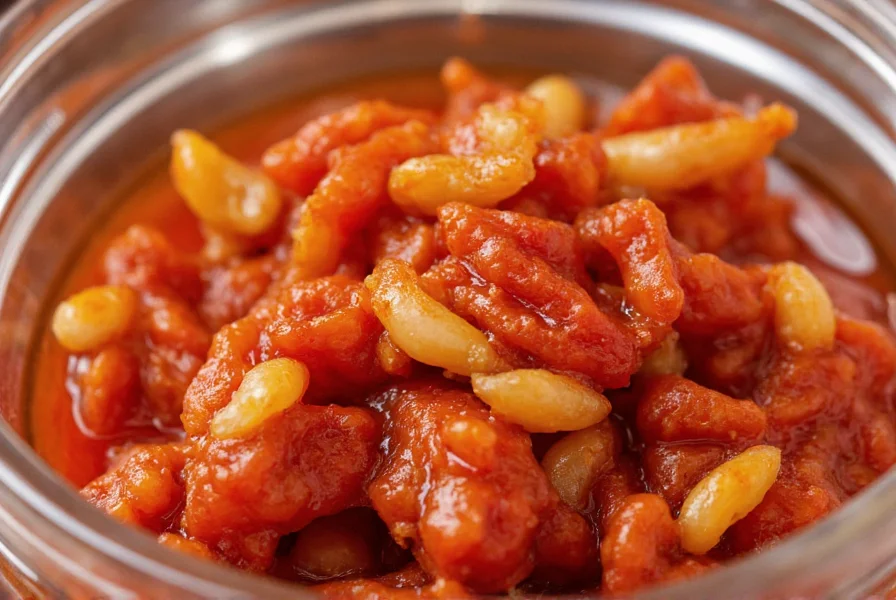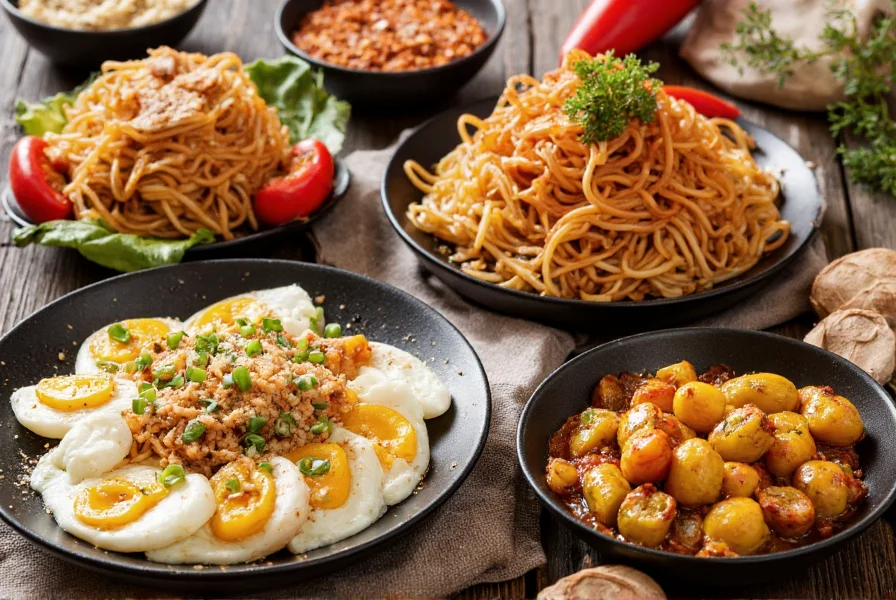For food enthusiasts seeking to elevate everyday meals, understanding this culinary staple opens doors to authentic flavor experiences. The magic of chili crisp lies in its dual nature: the infused oil carries deep flavors while the crispy bits provide textural contrast. This balance separates it from standard hot sauces that focus solely on heat.
What Makes Chili Crisp Unique Among Condiments
Chili crisp stands apart from other spicy condiments through its complex composition and preparation method. While sriracha and standard hot sauces are primarily liquid with smooth textures, chili crisp maintains a signature crunch from fried aromatics. The traditional preparation involves slowly infusing oil with dried chilies, Sichuan peppercorns, garlic, and shallots until each component reaches perfect crispness.
The oil base serves as a flavor carrier that permeates dishes, while the solid components add texture. This dual functionality makes chili crisp particularly valuable in cooking—unlike liquid hot sauces that merely add heat, chili crisp contributes both flavor depth and textural interest. Many commercial varieties also include fermented black beans or doubanjiang (broad bean paste), adding umami complexity that enhances rather than dominates.
| Feature | Chili Crisp | Standard Hot Sauce |
|---|---|---|
| Texture | Crispy bits in oil | Liquid, smooth |
| Flavor Profile | Complex umami, aromatic | Primarily heat-focused |
| Cooking Function | Flavor base + finishing touch | Finishing heat only |
| Storage | Room temperature (oil preserves) | Often requires refrigeration |
Historical Roots and Global Evolution
Originating in China's Sichuan province, chili crisp began as a regional specialty where cooks preserved aromatics in oil while extracting their flavors. The Sichuan culinary tradition emphasizes mala (numbing-spicy) sensations, achieved through the combination of chilies and Sichuan peppercorns. Traditional versions were homemade, varying by household based on available ingredients and personal preferences.
The condiment gained international recognition through chef David Chang's Momofuku restaurants, which introduced their version called " chili crunch." This sparked a global phenomenon, with numerous artisanal producers emerging worldwide. Despite its international popularity, authentic chili crisp maintains its Chinese culinary roots while adapting to local palates—some Western versions reduce the numbing Sichuan peppercorn element for broader appeal.
Practical Applications in Everyday Cooking
Understanding how to use chili crisp effectively transforms ordinary meals. Unlike hot sauces added at the end, chili crisp often serves as both cooking foundation and finishing touch. For optimal results when using chili crisp in noodle dishes, add a spoonful to hot oil before introducing other ingredients—this blooms the flavors and distributes them throughout the dish.
Consider these versatile applications for your chili crisp pantry staple:
- Stir into mayonnaise or aioli for instant dipping sauce
- Drizzle over roasted vegetables before serving
- Mix with soy sauce and vinegar for dumpling dipping sauce
- Add to scrambled eggs or tofu for breakfast
- Enhance store-bought broths and soups
- Use as pizza base instead of tomato sauce
When incorporating chili crisp into recipes, remember that a little goes a long way. Start with one teaspoon per serving and adjust to taste. The oil component carries flavor throughout the dish, while the crispy bits provide texture at the end. For those exploring authentic chili crisp recipes, traditional versions often include fermented black beans and star anise for additional complexity.
Evaluating Quality in Commercial Products
With numerous brands available, identifying high-quality chili crisp involves examining several factors. First, check the ingredient list—authentic versions should feature whole ingredients like dried chilies, garlic, and shallots rather than chili powder or artificial flavors. The oil should appear vibrant red from the chilies, not murky or discolored.
Texture provides another quality indicator. Premium chili crisp maintains distinct crispy elements rather than mushy or burnt bits. When shaken, you should hear the solid components moving through the oil. Brands using higher quality oil (like peanut or vegetable oil rather than cheaper alternatives) create a cleaner flavor profile that doesn't overpower other ingredients.
For those seeking best store-bought chili crisp options, consider these characteristics:
- Visible whole ingredients rather than purees
- Balanced heat level (not overwhelmingly spicy)
- No artificial preservatives or colors
- Distinct layers of flavor beyond just heat
- Properly crisped aromatics (not soggy or burnt)

Storage and Shelf Life Considerations
Proper storage maintains chili crisp's quality and extends its usability. The oil base naturally preserves the ingredients, allowing unopened jars to remain stable for 12-18 months at room temperature. Once opened, refrigeration extends freshness to 6-8 months, though the oil may solidify slightly when cold—simply bring to room temperature before use.
Unlike many condiments, chili crisp actually improves with short-term aging as flavors continue to meld. However, watch for signs of spoilage including:
- Mold growth on the surface
- Rancid or off odors from the oil
- Excessive darkening of ingredients
- Unusual bubbling or fermentation signs
When stored properly, your chili crisp condiment remains a versatile kitchen companion that enhances countless dishes with minimal effort. The oil base carries flavors beautifully through cooking processes, while the crispy elements provide that signature textural finish.

Creating Homemade Variations
For those interested in making chili crisp at home, the process requires patience but yields exceptional results. Start with high-quality dried chilies (like arbol or guajillo), fresh garlic, and shallots. The key technique involves slowly heating oil to extract flavors without burning ingredients—typically beginning at low temperature and gradually increasing.
Home preparation allows customization of heat level and flavor profile. Some variations include:
- Adding fermented black beans for umami depth
- Including Sichuan peppercorns for authentic mala sensation
- Using different oil bases (sesame, peanut, or vegetable)
- Adjusting garlic-to-chili ratios based on preference
When crafting your own version, remember that the cooling phase continues flavor development. Allow your homemade chili crisp to rest for 24-48 hours before use for optimal flavor integration. Properly stored in sterilized jars, homemade versions last 3-4 months refrigerated.
Conclusion: The Essential Pantry Upgrade
Chili crisp represents more than just a spicy condiment—it's a flavor foundation that transforms simple ingredients into complex dishes. Its versatility across cuisines and applications makes it worthy of regular use rather than occasional novelty. By understanding its components and proper usage, home cooks can elevate everyday meals with minimal effort.
Whether you're exploring authentic Chinese chili crisp traditions or experimenting with modern interpretations, this condiment offers endless possibilities for culinary creativity. The growing availability of quality commercial options means anyone can enjoy its benefits without extensive preparation, while homemade versions provide opportunities for personalization and deeper culinary engagement.
Frequently Asked Questions
What's the difference between chili crisp and chili oil?
Chili oil contains only infused oil with no solid components, while chili crisp includes crispy bits of garlic, shallots, and other aromatics suspended in the oil. This textural element defines chili crisp and provides additional flavor dimensions beyond what chili oil offers.
Can chili crisp be used as a cooking oil?
Yes, chili crisp works well as a cooking base for stir-fries and sautés. The infused oil carries flavor throughout the dish while the crispy bits add texture. However, avoid heating it to smoking point as this can burn the delicate aromatics and create bitter flavors.
Is chili crisp gluten-free?
Most traditional chili crisp varieties are naturally gluten-free, but some commercial versions may contain soy sauce or other gluten-containing ingredients. Always check labels if you require strictly gluten-free products, as manufacturing processes can vary between brands.
How spicy is typical chili crisp?
Heat levels vary significantly between brands and regional variations. Traditional Sichuan versions tend to be moderately spicy with prominent numbing sensation from Sichuan peppercorns, while some Western adaptations reduce the heat for broader appeal. Most commercial products offer mild to medium heat that enhances rather than overwhelms dishes.
Can I make chili crisp less spicy?
Yes, you can reduce spiciness by using fewer dried chilies or removing seeds before preparation. When using store-bought versions, start with small amounts and adjust to taste. Mixing chili crisp with neutral oils or adding sweet elements like honey can also mellow the heat while maintaining flavor complexity.











 浙公网安备
33010002000092号
浙公网安备
33010002000092号 浙B2-20120091-4
浙B2-20120091-4